#shofar music
Video
youtube
[Special Clip] 최유리 - '이름' (연습실 Ver.) https://youtu.be/FSva6jKjuHs 최유리 2023 첫 단독 콘서트 D-1! 콘서트를 기다리는 여러분들을 위한 선물이 도착했습니다💌 ⠀ #최유리 #굄 #이름 #콘서트 #CHOIYUREE #Yourname #Shorts 쇼파르엔터테인먼트
0 notes
Text
All I remember is there were parachuting, shofar-playing chickens involved.
171 notes
·
View notes
Text
Musical Instruments I Play, Rated by My Dinosaurs (pet parrots)
Piano - 5/10
its not scary bc it doesn't move
the music isn't very good though. no singing. even for mozart.
Oboe - 3/10
looks like a snake
but very p music keep playing just NEVER MOVE
Kalimba - 7/10
not scary at all bc small
very pretty music let's beep along beep beep beep
Tambourine - 5/10
not very scary until it SHAKES
not worth singing along to tho
Shofar - 1/10
SCARY SCARY SNAKE THING
LOUD WHAT THE HELL
FLY EVERYWHERE LIKE CRAZY
Guitar - 0/10
the scariest thing in the universe. apparently.
but instead of flying around a lot they scream at it until it goes away
Recorder - 10/10
its small! its safe! no scared birds!
I think they think the recorder is just a weirdly shaped bird because they sing along with it every damn time
304 notes
·
View notes
Text
Okay I lied, one more post about the blatant antisemitism that isn't getting as much as attention as the creator's cissexism.

Thread from Unsidhe, Artist&Vtuber|Illust/Live2D OPEN on Twitter:
cw: antisemitism 1 of the 'goblin artifacts' you can find in That Wizard Game is literally just a shofar, a Jewish musical instrument, described as being 'used to annoy witches and wizards'. In it's description is the year 1612, which was when the Fettmilch uprising took place.
This uprising was followed by an outright massacre of Jewish people. If you STILL think it's just "a coincidence based on unfortunate folklore about goblins" and not literally an antisemitism propaganda simulator, fucking BLOCK ME. I want nothing to do with you.
People are trying to tell me "but it's not a shofar because it's painted" like, you're grasping at straws for excuses at this point.
Learning that they wrote 'stuffed with gorgonzola to silence it' about the horn, and finding out that gorgonzola specifically is not a kosher cheese... when they could have just written 'stuffed with cheese' for the Haha Funney Points really says a lot someone had to think.
/end thread
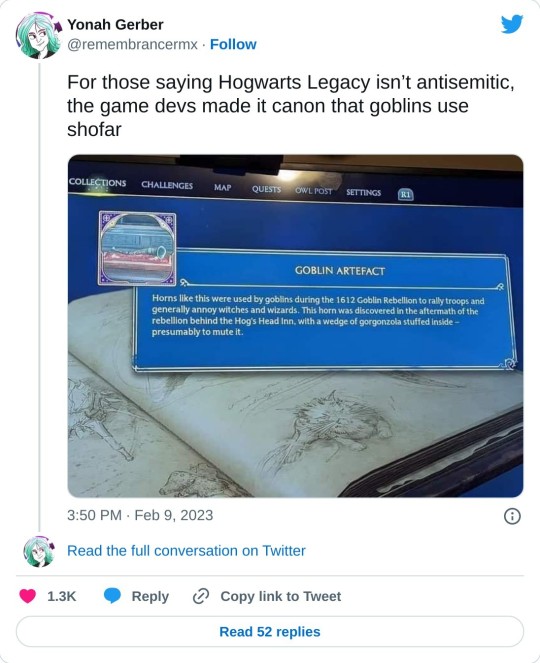
Thread from Yonah Gerber on twitter:
For those saying Hogwarts Legacy isn’t antisemitic, the game devs made it canon that goblins use shofar
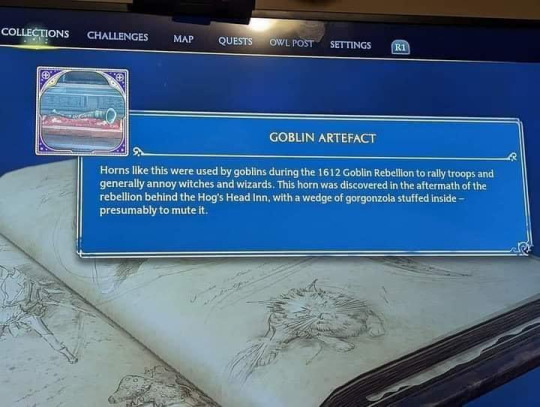
“Generally annoy witches & wizards” literally the text in the game is that Jewish practices are just an annoyance like what the fuck
To address the dumbassery in my responses: assume good intentions must be earned. If this was the first time a Rowling property has been antisemitic, that's a woopsie. But it's not.
Here's the facts as they exist: - The object is a war horn - The artifact in the game is located at a place named after a pig & stuffed with dairy products to stop its music - The year of its most famous use is also the year major antisemitic pogroms happened in Germany
If ONE of these things were true, but Rowling & the franchise otherwise hadn't made any major missteps, that's when we give the benefit of the doubt. But I'm not willing to give said benefit when considering all the in-game context AND ALSO prior antisemitism in the franchise.
At a certain point, "benefit of the doubt" becomes "any plausible deniability is sufficient to ignore all context to the contrary" & to me, & to many Jewish folks, we are way past that point.
Hogwarts Legacy is not the first time the Harry Potter franchise has been accused of antisemitism. If the franchise & its creators wanted to avoid further accusations, they could've done some basic historical research to make sure these alleged coincidences were not included.
Once you have harmed a marginalized demographic, it's on your as a creator to prevent *further harm*. If you're using an IP that another creator once used to harm others, then I'm sorry, you do have the responsibility to undue that harm where you can in your own work.
EVEN IF these are coincidences, had the development team made a point to avoid antisemitic caricatures & educated themselves on that history, this wouldn't have happened. They chose not to care. And that's not much better, really.
Obviously I don't know what the team at Avalanche thinks or believes & frankly that's not my business. What matters to me is the end product & that end product either is purposefully antisemitic or was made by folks who don't care if they're accidentally antisemitic.
However you twist this, there's a tremendous lack of care going on here, & a choice to perpetuate cruelty that didn't need to happen.
Don't yell at folks in my mentions who genuinely don't understand the layers of context here. This is a great education opportunity. Block the obvious trolls, I sure am, but some folks have only seen a piece of the whole, & education is the best solution to ignorance.
Deleting my last tweet because I saw the point on Mastodon, but I can no longer find the post. I don't want to share what I can't currently verify.
To add, though: - The shofar is located at the Hog's Head (aka pig) Inn - The music of the shofar is prevented because a wedge of gorgonzola was used to stop the music, & while many cheeses are kosher, that one is not Take from that what you will.
/end thread
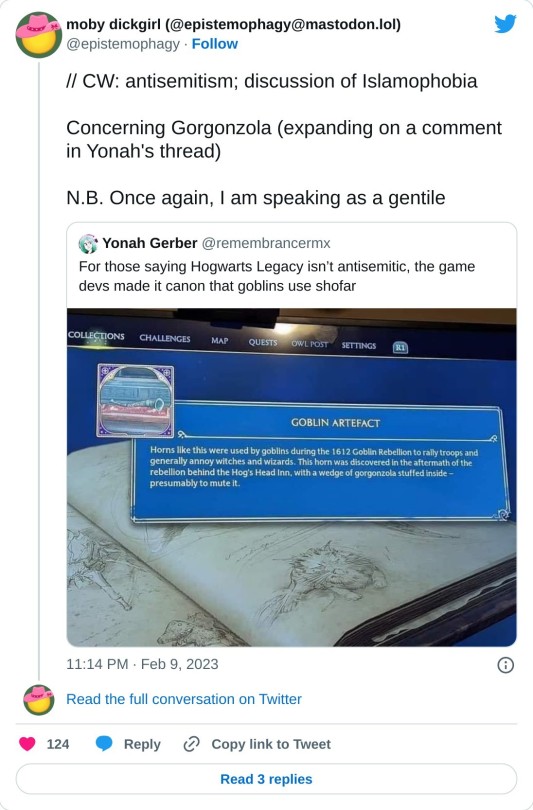
Thread from moby dickgirl on Twitter:
// CW: antisemitism; discussion of Islamophobia Concerning Gorgonzola (expanding on a comment in Yonah's thread) N.B. Once again, I am speaking as a gentile
It's a really common trope in right-wing propagandistic fiction for the "heroes" to desecrate the graves of religious enemies by putting profane items in them. The example I'm most familiar with is endless post-9/11 masturbation about putting pig products in Muslims' graves
I understand that there's a prohibition, deriving from a law given by Moses at Sinai, on seething a kid in its mother's milk, and that this is generally interpreted pretty broadly as meaning having meat and dairy in the same meal, or otherwise combining them, is unkosher
Some cheeses are kosher. Traditionally, Gorgonzola is not. This is because the production of Gorgonzola requires the use of a complex of enzymes called rennet. Using animal-derived rennet to make cheese is unkosher because of the prohibition mentioned above.
Now, this doesn't always apply to Gorgonzola today; you can get Gorgonzola made with non-animal-derived rennet which I understand may be kosher. However, this was unequivocally not the case in 1612. Gorgonzola made then would have been made with animal-derived rennet.
It's also been noted that the year of that goblin rebellion is 1612, the first year of the antisemitic purge called the Fettmilch Rising in Frankfurt. Both the real Fettmilch Rising and the fictional rebellions may have been based partly on allegations of financial misconduct.
There is, however, a shorter path. A distinctive quality of Gorgonzola — unique to it as far as I can tell — is that it's made with unskimmed milk, that is, milk with the milkfat still in it. The German word for "milkfat" is "Milchfett" — "Fettmilch" with the syllables reversed.
(I've heard that "Fettmilch" is literally a dialect German word for "unskimmed milk," which would make the link even more direct, but I don't have a sufficiently comprehensive German–English dictionary on hand to confirm this. German speakers are welcome to chime in.)
/end thread
Not to mention that the basic plot of the game is suppressing the rebellion of a canonically oppressed race that has always been an antisemitic caricature (hooked nose, beady eyes, hoard money, apparently control the wealth, manipulative, sneaky, greedy). We didn't need to look far to find the antisemitism, and yet here it is, ratcheted up times ten.
#hogwarts legacy#jk rowling#harry potter#hp goblins#antisemitic#antisemitism#oh fuck just lemme piss off the hoards of radfems still clinging to life here#oh and by the by#the supposed trans-inslucisivity comes in the form of a trans woman named Sir Ryan#islamophobia#THE GAME IS A FUCKING PRO NAZI PLOT#nazis#nazism#long post
185 notes
·
View notes
Text
The Prince of Egypt
Roundtable Discussion
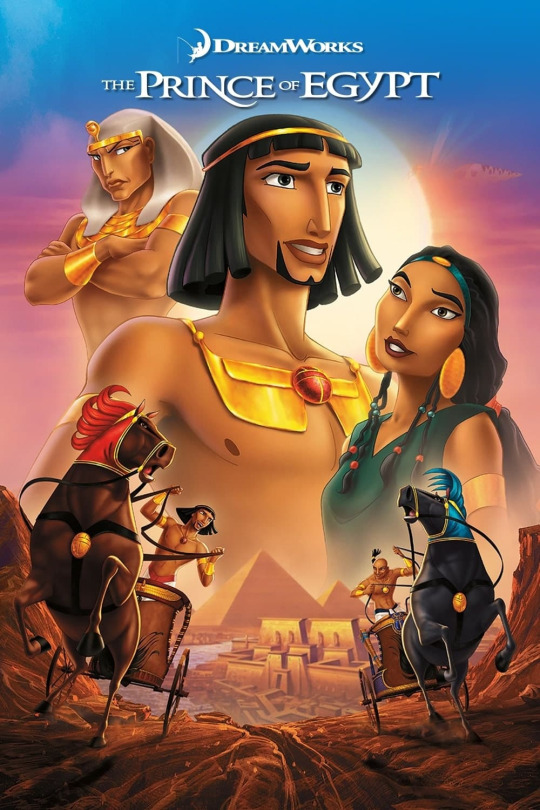
In what ways does the film’s score situate the story with its narrative context?
youtube
timestamp: (1:19)
The film’s score acts as a major storytelling device. Each song provides key information about the narrative, explores developments in characters, and can show the passage of time within the story. In “Deliver Us”, we learn about the context of the enslaved Israelites in Egypt, the order from Pharaoh to kill every newborn Hebrew boy, and Moses’ mother Jochebed’s attempt to save him from the infanticide. “The Plagues” serves a similar plot-based purpose and definitely situates the narrative within the book of Exodus while maintaining the rivalry between brothers. The film’s score uses an overture and several reprises to fully embed the songs into plot and characterize this narrative as epic.

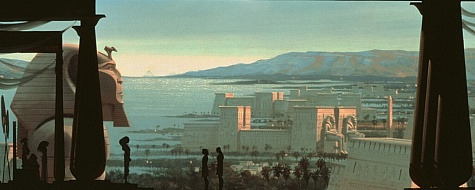
How do songs use character performance to push cultural authenticity in the film’s diegesis?
Songs include Hebrew language in their lyrics to push cultural authenticity. For example, Ofra Haza’s vocal performance in “Deliver Us” is one of the few vocal performances from a non-white person in the film. Like Armstrong notes, “Moana is not the first production for which Disney hired cultural ‘natives’ to grant cultural authority to offset criticism of imperialism”.
Haza's inclusion as the mother of Moses is a powerful and meaningful role, but she only appears at the beginning of the film. This character performance is used to push cultural authenticity as Ofra Haza is a famous Israeli singer who sings Hebrew in the song. The fact that she “stands out” is indicative of the limited casting—she is casted alongside famous, mostly white American actors.
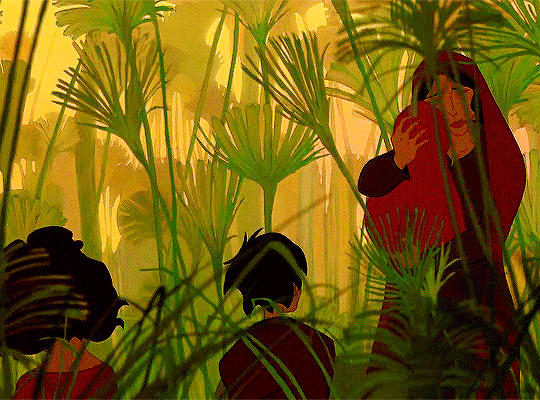

In what ways does the film use musical “framing” to structure the score within familiarized styles?
Like in Moana, musical framing is also present in The Prince of Egypt’s score, composed by Hans Zimmerman. Traditional and culturally significant instruments like the shofar (which sounds like a horn), the flute, and percussion like the Darbuk and Toft, seem to be included in the score. These "unfamiliar" instruments however are sandwiched by and interspersed with “a familiar set of ‘normal’ musical sounds” like Armstrong mentions. The score is “framed” with choir vocals, french horn, strings, and other Western instruments.
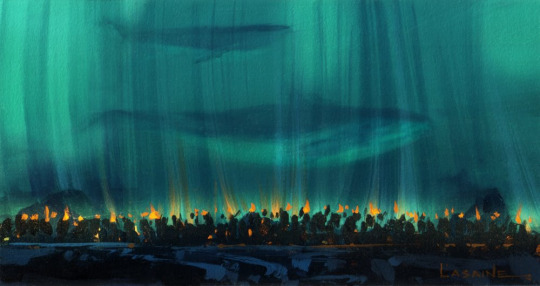
19 notes
·
View notes
Text
"The new issue drawing ire from people is the inclusion of a shofar, a Jewish musical instrument in Hogwarts Legacy. It's a goblin artefact that's described as being "used by goblins during the 1612 Goblin Rebellion to rally troops and generally annoy witches and wizards."
In Germany, 1612 - in the real world, not the Harry Potter books - there was a pogrom in Frankfurt. Pogroms are organised massacres of Jews, and this instrument which looks exactly like a Jewish shofar was used during a Harry Potter rebellion in 1612 involving a race that for decades has been accused of being antisemitic."
.
.
"Even if you can separate the art from the artist and enjoy the game without considering the fact it's lending authority and cultural cache to JK Rowling and her transphobic views, how are you finding this game about crushing a clearly Jewish-coded uprising cosy and cute and fun?"
#antisemitism#hogwarts legacy#anti hogwarts legacy#anti jk rowling#transphobia#article#my post#harry potter
32 notes
·
View notes
Video
youtube
https://www.youtube.com/watch?v=UnaCy3PVhfQ
Rosh Hashana is sometimes called “the birthday of the world.” Like a lot of us in the modern era, the world’s birthday celebrations extend beyond a single day -- at least two days of Rosh Hashana, and one could make an argument certainly through Yom Kippur and possibly Shemini Atzeret as well.* But certainly for Rosh Hashana, we make sure to sing a birthday song for the world, and it’s this one. It’ll probably be on Day 2, though, since Day 1 this year is Shabbat, and we don’t blow the shofar on Shabbat, and this comes after the shofar service during the Musaf Amidah.
This setting is by Julius Mombach, the fellow who really shaped the sound of nineteenth-century Anglo-Jewish music.
*I recently learned that the reason I never quite believed that Shemini Atzeret was a Real Holiday™ is because the American Reform movement has quietly dropped it. Since I came up Reform, I occasionally heard of this thing called Shemini Atzeret, but had no idea what it was, or even if it was a Real Thing. My current American Conservative synagogue does believe that Shemini Atzeret is a Thing, but they cannot explain to me the nature of the Thing. I still think Reform got this one right.
6 notes
·
View notes
Text
How to not appropriate Judaism in these trying times
Since antisemitism is (surprise!) on the rise again, I suspect y’all may find yourselves at an event supporting Jews or against antisemitism. Most folks will be there to help and may worry about what they can do without accidentally being appropriative, so I thought I might chime in.
(My bona fides: I’m a Jewish atheist, moderately well-educated but not expert in Jewish law and tradition, and also a frequent attendee at rallies, marches, protests. Also, I volunteer with Jews United for Justice. My fellow Jews can feel free to add, correct, or debate what I say.)
The good news is that the vast majority of the time you won’t have to worry about appropriation as long as Jews organized the rally! They know what non-Jews can and can’t do and will let y’all know. Generally if Jews are in charge, you can do whatever everyone else is doing.
Important note: The “Jews for Jesus” or “Messianic Jews” are not Jews. Do not attend any event run by them or grant them any legitimacy.
If a rally is organized by non-Jews or if you’re unsure, here are some things to know:
Under no circumstances should a non-Jew wear a tallis (prayer shawl with fringes on the ends). Never. Nope. Don’t do it.
Non-Jews generally shouldn’t blow a shofar (the curly ram’s horn that makes an amazing racket). The only exception is if there are no Jews with the appropriate musical training and you happen to play a wind instrument. But do not offer to blow the shofar unless the event is run by Jews. It’s fairly common for some Christian denominations to appropriate the shofar and it’s super rude.
Most of the prayers will be in Hebrew, so you’re likely not in danger of doing something problematic. There are some songs that are just fine for non-Jews and you may get a paper with the lyrics transliterated. For example, “Hinei Matov” is fine. (It’s also lovely and should be sung more.)
If a song is sung in English, it should be fine for you to sing along.
If you’re at a candlelight vigil, you may hold a candle. It’s probably best to avoid doing anything that looks like a ritual candlelighting, just in case. You can be a spectator, but don’t light anything yourself.
You can eat any food that’s offered. We don’t have an equivalent to Mass or sacred crackers. In fact, if you don’t eat, that might be more offensive ;)
In return, I’d love to know what I should/shouldn’t do at (for example) a Black Lives Matter rally or a march in support of our Muslim neighbors. I do know that “rest in power” is for non-White activists only and that as a white person I shouldn’t put myself in front of the other marginalized people (unless it’s to stand between cops and protestors).
22 notes
·
View notes
Text
Una serie di canzoni scritte per gli ebrei da un cantautorato italiano e straniero di sinistra..non ne riesco a trovare una, che sia una per i palestinesi di Hamas...chi glielo dice adesso ai loro fun fluido-gender-68ini- lgtb-green- arcobaleno-kefiah addict ?
Francesco De Gregori – Numeri da scaricare
Franco Battiato – Il Carmelo di Echt.
Il diario di Anna Frank – I Camaleonti
Francesco Guccini - Auschwitz
Giorni senza memoria – Radiodervish
De Andrè - Khorakhané
Baustelle – Il Finale
Lou Reed – Good Evening Mr Waldheim
Joy Division – No Lost Love
Bob Dylan – With God On Our Side
Slayer - Angel of Death
Dance me to the end of love – Leonard Cohen
Gam Gam - Elie Botbol ( la più toccante cercate il significato)
In foto lo shōfār strumento a fiato fatto di corno di ariete . Era usato fin dai più antichi tempi della storia d'Israele per suonare l'allarme, lanciare le truppe all'assalto, terrorizzare il nemico e convocare le assemblee...oggi dedicato per "suonare" Hamas
#shofar #israel #singasong #cantautorato #warsong #israele🇮🇱 #army #music #vibes #mood #strumentimusicali #idf #sayeret
instagram
2 notes
·
View notes
Text

When you hear the Shofar being blown next week, consider this: it is the oldest musical instrument in the world still in continuous use. It sounds today just as it sounded at Mount Sinai, or when Jericho fell, or when King Solomon was crowned, or when Jerusalem was reunified in 1967. It is the very embodiment of Judaism. Wishing everyone a Shana Tova 5783 and well over the fast.
Likud UK
22 notes
·
View notes
Video
youtube
[Special Clip] 최유리 - '이름' (낭독 Ver.) https://youtu.be/LjNRyxVOesU 우리는 서로의 이름에 온갖 사랑과 애정을 담습니다. 애정을 담아 읽어드리는 최유리의 '이름' 한번 들어보실래요?💕 ⠀ #최유리 #굄 #이름 #낭독 #CHOIYUREE #Yourname #Shorts 쇼파르엔터테인먼트
0 notes
Text
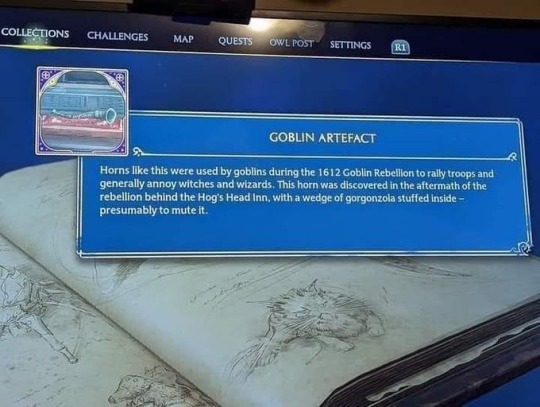
Just learned from Tiktok that they used a Shofar as a ‘goblin artefact’.
As if the stereotypes and the blood libel wasn’t enough... Even if we try to ‘separate Harry Potter from Jk Rowling’ the game is still packed with harmful antisemitic stereotypes.

For people who don’t know this is a Shofar, it’s a musical instrument used by Jewish people during religious ceremonies
#i am trans jewish and TIRED#i don’t want to get into endless fights but how do people not see this ?#the antisemitism is blatant#anyway please don’t play hogwarts legacy#hogwarts legacy
12 notes
·
View notes
Text
@slingsandarrowroot :A gemsbok cornetto would be amazing! I have a cornetto laying around that I could measure the fingerholes from, and you could probably scale from that.?
thanks for the offer. but I think the first step would be to source an ethical and cleaned gemsbok horn and actually look at it properly. because even if we scale the cornetto measurements to where it's the same length as the horn, my gut feeling is the horn has a wider bore (or a least a wider flare) which will affect the fingerholes' spacing and size too
I know there's a formula for calculating flute/recorder fingerholes, so there must be one for conical bore instruments too ? in Robinson's Amateur Wind Instrument Maker he does provide dimensions for cornetti (picture below), but doesn't give the formula... I may have to work through the bibliography and see what I can find
and btw, what cornetto do you have ? I've been considering one of Jeremy West's resin ones

#cornetto#cornett#zink#shofar#horn#instruments#music#also idk how brittel horn is and whether one can even drill into it#might have to carve and sand the holes manually or with a dremel idk ?
5 notes
·
View notes
Text
Jessica Pavone — Clamor (Out Of Your Head)

Building on the compositional approaches that she developed in Lull (2021) and Lost and Found (2020), Jessica Pavone presents a concerto for sextet and bassoon soloist. The four movements of Clamor are inspired by the composer and violist’s readings of feminist writings and exploration of inventions by women. The result is at times harrowing, often strikingly beautiful, and consistently engaging.
Pavone’s methodology involves the articulation of phrases for specific periods of time, which listeners soon come to anticipate so that the shifts serve to propel the compositions. Solo voices emerge at times, but the sound of the ensemble dominates, creating a powerful drone. For this recording, Abby Swidler joins Pavone on viola, with Aimée Niemann and Charlotte Munn-Wood on violin, Mariel Roberts on cello, and Shayna Dulberger on double bass and Katherine Young contributing the bassoon.
The opening movement, “Neottwigi,” is named for and features a back-and-forth rhythmic pattern suggestive of a kind of see-saw used by Korean women in the middle Joseon period to glimpse the world outside the walls in which they were sequestered. Beginning as a fairly undifferentiated mass, the drone evolves as the players shift at the allotted times, remaining vaguely ominous and slow until around the three-minute mark, at which point a run of bass notes introduces the see-saw pattern. The pitches grow higher for several minutes, and then the see-sawing comes almost to a stop, as if time freezes for a woman as she peers beyond her domestic confinement. The movement then resolves gently and peacefully until the final minute, when the ominous drone reforms, deeper now, and the ensemble stops on a dime. There is a strong narrative quality to this riveting piece of music; it is easy to imagine over the course of it small groups of women gathering furtively and then constructing and mounting their neottwigi, viewing the wider world for a moment, and then returning to strictures of the household.
The two movements featuring Young, “Nu Shu 1” and “Nu Shu 2,” named for a Chinese syllabary devised by women for their own use, form the core of the concerto. The bassoon introduces itself like the blaring of a shofar. The sound is massive, initially rendering the string instruments feeble by comparison as they begin to fill the gaps. A new path emerges around the four-minute mark as the bassoon, braying less forcibly, develops a more complex theme, eventually enticing the strings to join. The next shift is inaugurated by rattling and breathing like static from which long string notes emanate until, in the final minute, the ensemble melds together. The sonic struggle between the bassoon and the strings continues in “Nu Shu 2,” which builds on the tension of the previous movement with horror-movie strings and an amazing range of sounds from the bassoon, all of which culminates in a roar.
“Bloom” ends the concerto on a gentler note, beginning with a lovely viola solo that is enveloped by the other strings, which become more high-pitched and discordant as they alternate with doleful but harmonious bass and cello. Then, in the final minute, all six voices combine in a swelling and, perhaps, optimistic finish.
While each movement of the Clamor concerto is distinctive, the four tracks form an organic whole and are best listened to as a single experience, with the quieter opening and closing movements contrasting with the more noisy movements featuring the bassoon to lend a satisfying structure to the piece. The appeal to fans of contemporary classical music is obvious, but the improvisational spirit will speak to jazz listeners, and the almighty drone will appeal to those with a taste for, for example, Pauline Oliveros and Henry Flynt.
Jim Marks
#jessica pavone#clamor#ramp global#jim marks#dusted magazine#albumreview#contemporary classical#chamber music#experimental#queens#Bandcamp
2 notes
·
View notes
Text
the problem is that I have comparatively little knowledge of traditional Jewish music (yes I know it’s not a singular thing, you get me) but I *think* there’s something to the idea that Schoenberg opened up possibilities for note expression in the Western system that are related to that music, in a way that’s analogous to what Coleman allowed for blues enunciation when he dropped the piano (no more ties to the equal temperment tonality…) I think this actually might account for that attraction I noted as a joke before. You can’t actually do the wail of a shofar (or a shenai) in a contemporary jazz context sans Coleman
4 notes
·
View notes
Text
Thistlefoot Review
Thistlefoot by GennaRose NetherCott
CW: Violence, Xenophobia, Antisemitism, Death, Genocide, Self-harm, Suicidal Ideation, Swearing, Toxic Parental Relationship, Money Problems, Homelessness, Possession, Child Death, Drinking, Blackmail, Gore, PTSD, Self Loathing
5/5
I have found in my attempts at using dating apps that the media/entertainment recommendations of my matches tend to stick with me a lot longer than the people do. I say this to be funny, not for pity. Months ago I matched with a book-loving girl who gave me the perfect book rec. I told her about my blog being Queer and Jewish-based, and she immediately suggested Thistlefoot by GennaRose Nethercott. It took a while for it to get to me on Libby, but it was absolutely worth the wait!
Thistlefoot is about two magical siblings, Isaac and Bellatine Yaga. They are left a living house from their great-great-grandmother, Baba Yaga. Isaac and Bellatine are young adults now and haven't seen each other in 6 years. They don't trust each other, but they're willing to work out what to do with the house. Isaac has some debts he wants to clear and Bellatine wants the freedom that comes with a house that can walk. So they decide to continue their family business of puppet shows for one year, adding a stage to the house. Unfortunately, the house wasn't the only thing Baba Yaga left them. The past is coming back through an old enemy who wants the house destroyed.
Folklore, the past, and the concept that the body remembers trauma are all very important to Thistlefoot. Nethercott did a lot of research on folklore while writing the book. She looked into her Russian roots and quite a lot of American stories. She incorporated as much as she could into the book and wrote her own in as well. Folklore also affected how the story was told. Most books in third person have a narrative to explain what's happening outside of dialogue, but it's rare for them to feel like a character. In Thistlefoot, you aren't just reading a story, you're being told one. Perhaps it's Nethercott inserting herself into the story. Throughout, you also get interjections from Thistlefoot, the house, as she tells you interesting, but misleading information about the past.
I absolutely loved the experience of reading Thistlefoot. I didn't really know what was going to happen as I went through, even down to the last page. Every bit of the present, past, and history unfolded when the time was right. The story centers on a group that doesn't want to care about each other, but can't help themselves. Isaac and Bellatine are joined by a musical trio that just wants to fix the world and a girl that Bellatine brings to life with her animation powers. Basically, everyone has something about themselves that they aren't sharing, and that absolutely includes the house. Some pieces are revealed more cinematically than others, but they all contribute to why this book is so popular.
Despite the fact that Baba Yaga is not traditionally Jewish, I think it was a smart move to make that her religion. Russia's history of pogroms and antisemitism plays an important role in the story. There are many happier aspects of Judaism incorporated as well, such as traditional names, the use of Yiddish, and a shofar. Alongside the Jewish representation is queer representation. Bellatine has a romance with another woman, Baba Yaga was happier as a widow than married, Isaac had complex feelings for his best friend, and Sparrow the musician is non-binary. More diversity than this is included in Thistlefoot, making the book that much more relatable.
Nethercott spins an epic tale and race against time in Thistlefoot. If you're looking for a cinematic book that you can feel like a part of, I highly recommend this one. Puppetry, folklore, and memory come together to tell a tale you won't forget!
#thistlefoot#gennarose nethercott#bookblogger#book blog#queer books#queer characters#jewish books#wlw#jewish authors#baba yaga#folklore#nonbinary rep#contemporary fantasy#magic powers#puppets#isaac and bellatine#happy pride 🌈
4 notes
·
View notes